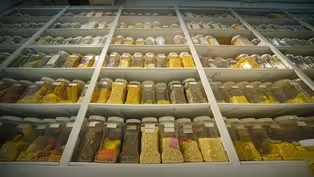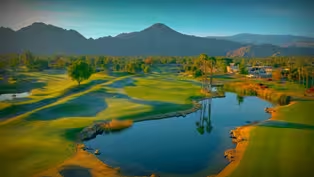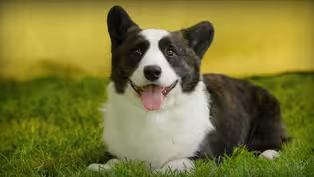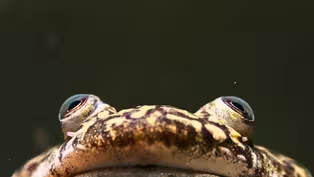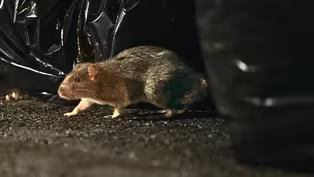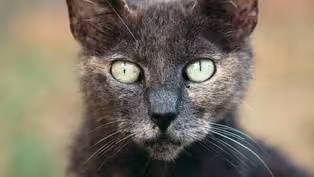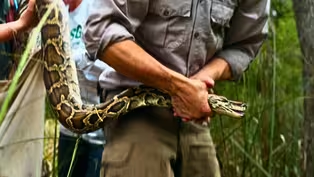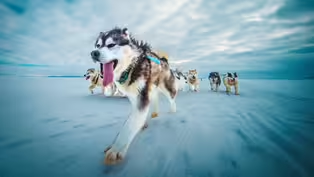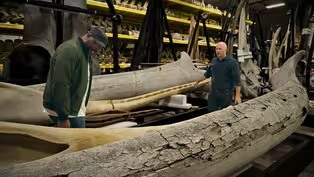
Why Are These Urban Lizards Evolving in Overdrive?
Special | 10m 33sVideo has Closed Captions
Examine city-dwelling anoles with remarkable evolutionary changes.
Puerto Rican Crested Anoles are a prime example of adaptation in action. In just a few decades, these city-dwelling lizards have undergone remarkable evolutionary changes to thrive in an urban landscape. Longer limbs, stickier toe pads, and higher heat tolerance are just a few of the adaptations they've developed. Discover this captivating world with Shane Campbell-Staton and Kristin Winchell.
Problems playing video? | Closed Captioning Feedback
Problems playing video? | Closed Captioning Feedback

Why Are These Urban Lizards Evolving in Overdrive?
Special | 10m 33sVideo has Closed Captions
Puerto Rican Crested Anoles are a prime example of adaptation in action. In just a few decades, these city-dwelling lizards have undergone remarkable evolutionary changes to thrive in an urban landscape. Longer limbs, stickier toe pads, and higher heat tolerance are just a few of the adaptations they've developed. Discover this captivating world with Shane Campbell-Staton and Kristin Winchell.
Problems playing video? | Closed Captioning Feedback
How to Watch Human Footprint
Human Footprint is available to stream on pbs.org and the free PBS App, available on iPhone, Apple TV, Android TV, Android smartphones, Amazon Fire TV, Amazon Fire Tablet, Roku, Samsung Smart TV, and Vizio.
Buy Now

Surprising Moments from Human Footprint
Do you think you know what it means to be human? In Human Footprint, Biologist Shane Campbell-Staton asks us all to think again. As he discovers, the story of our impact on the world around us is more complicated — and much more surprising — than you might realize.Providing Support for PBS.org
Learn Moreabout PBS online sponsorshipMore from This Collection
Human Footprint is a show that delves into the impact of humans on the planet. Join Shane as he travels from farms to restaurants, from high-tech labs to street markets, and from forests to cities to uncover the consequences of our unique history. Are you ready to explore our past, present, and future as a species?
Video has Closed Captions
Watch the rise of a productive crop that has managed to replace itself, but at what cost? (11m 24s)
The Watery Price Of Golf Courses & Lawns
Video has Closed Captions
The cultural and resource costs for manicured lawns and golf courses are quite shocking. (11m 29s)
How Dogs Are Shaping The Future Of Medicine
Video has Closed Captions
Observe the rich diversity of dog breeds, shaped by genes and human intervention. (12m 43s)
We Brought This Fish To America. Now We Can't Get Rid Of It
Video has Closed Captions
Expose Asian carp for disrupting native fish species and shrinking their populations. (10m 39s)
How An Ancient Ocean Shaped Us History
Video has Closed Captions
Learn how millions of years of deposits shaped the events of Black American history. (16m 54s)
Video has Closed Captions
What happens when frogs become indispensable? (8m 59s)
Video has Closed Captions
When it comes to NYC, the rat is the undisputed king! (13m 26s)
Your Cat’s Secret Life (as a Deadly Predator)
Video has Closed Captions
Cats have been winning the hearts of humans for years....but can devastate ecosystems. (10m 40s)
Singapore: Designing a Megacity in Harmony with Nature
Video has Closed Captions
Green spaces aren't just an afterthought here - they're mandatory! (13m 24s)
How Giant Pythons Became Florida’s Biggest Invasive Species
Video has Closed Captions
Ever heard of the phrase "when pet pythons outgrow their owners"? (13m 24s)
Sled Dogs: The Most Extreme Distance Athletes on Earth
Video has Closed Captions
In the Arctic, it's not just about muscle power, but brainpower too. (15m 17s)
Secrets of the World’s Only Whale Warehouse
Video has Closed Captions
Uncover the history of whaling and its impact on our oceans. (9m 58s)
Providing Support for PBS.org
Learn Moreabout PBS online sponsorshipSo I set up a lizard race track, and I fitted the race track with different surfaces.
One was tree bark, one was metal, like fence post metal, and then one was painted concrete.
And then I took high speed video of these lizards racing up the race track.
You might be wondering why we're racing lizards, and I promise it's science and definitely not an underground lizard-gambling ring.
There are more than 400 species of anoles throughout the Caribbean, Central and South America, and the southeastern U.S. That diversity has made them an unlikely hero in the science world because of their remarkable ability to adapt to different environments.
Biologists, like me, have studied them for decades…and published literally thousands of papers on them.
But one thing we’re still trying to answer is how these lizards are evolving to thrive in yet another major ecosystem: cities.
It turns out these scaly city slickers are adapting to urban life in some really surprising ways.
I’m Shane Campbell-Staton, and this is Human Footprint.
Juan Ponce De Leon founded the settlement that became San Juan, Puerto Rico in 1508, making it one of the oldest colonial cities in the Americas.
Five hundred years later, that tiny colony has grown into the 3rd largest city in the Caribbean Islands.
But amazingly, you can still see native wildlife here.
If you walk through the city, you'll just see them on everything.
Kristin Winchell is an expert in urban evolution.
She studies lizards called anoles, which live all over the American tropics.
For Kristin, anoles aren’t just a scientific inspiration… they’re also her artistic muse.
I guess first of all, what is the greatest animal, and why is it anoles?
I don’t know, they're just fantastic little critters.
They're so expressive and so charismatic.
And, I mean, they're also great for scientific study.
If you can’t tell, I’m a big anole fan, too.
I used to catch them as a kid in South Carolina.
And I’ve been studying them since grad school.
Kristin and I actually work together on anole research here in Puerto Rico.
I feel like most people they're like, "Okay, I want to study them in forests” and things like that.
You decided to go study them in the city?
It was because I was looking for a species that might be adapting to urban environments.
I came across anoles and started reading about their rich evolutionary history and rapid change after you modify the environment.
I just had this moment where I was like, "If this is happening, it's in these guys.” Once you know what you’re looking for, anole adaptations can be easy to spot.
You see, species that live in different habitats have different traits: Big toe pads that help them stick to leaves in the treetops… Long legs that allow them to run fast on the ground… Short legs that help them climb without falling on the tiniest twigs… And so on.
Kristin’s question was, which of these traits, if any, would help anoles survive in the city?
Alright, let’s find some lizards.
Kristin and I study the Puerto Rican crested anole.
Step one is to find out whether urban and forest anoles are different from one another.
Say it, and the lizard gods will deliver.
Yeah, there’s a female right there.
So we hit the streets to catch some lizards.
Oh, she's squirrely.
You’re too slow, K… stop embarrassing yourself on TV.
I had one and then I let... Yeah.
Okay.
Thanks Shane.
That's real nice.
Invite me on your show and then make fun of me.
Catching anoles is a delicate, scientific process involving a fishing pole and some string.
You go out in your hiking boots and your field clothes… Well you're going to get a lot of looks.
You dress casual like you're going out on for a little walk, even bring a little boombox with you.
That helps a lot because no one walks around doing sketchy stuff listening to reggaeton.
Got him first.
Hey, bud.
We measure with a digital x-ray all the bones in the body.
And you can see that they have these enlarged toe pads on the fore and the hind feet.
And so if you were to zoom way in on those, you'd be able to see these tiny scales, and those let the lizards cling to the smooth surfaces.
So for the Puerto Rican crested anole, what did you find?
One of my initial findings was that … in the city … the lizards had longer limbs relative to their body length, larger toe pads with more of these specialized scales on the toe pads.
Okay.
These are exactly the kinds of adaptations you might expect to see in cities, based on what we already know about anoles living elsewhere.
They're clinging to things like glass and metal and even painted concrete, which is a lot smoother than anything you find in the forest.
And so there's kind of this combined selective pressure on toe pads, making them able to cling better and limb length, making them able to navigate the structural environment better.
Okay.
The urban lizards were different, but the real test was whether they could actually outperform their forest-dwelling counterparts when facing a uniquely urban challenge.
So I set up a lizard race track, and I fitted the race track with different surfaces.
One was tree bark, one was metal, like fence post metal, and then one was painted concrete.
And then I took high speed video of these lizards racing up the race track.
What I expected is that the urban lizards would be able to run faster on the concrete and the metal and the urban substrates.
Those are the environments that they were living in.
Yeah, exactly.
And so they'd be better at doing that than the forest lizards.
What I found though was that the urban lizards were just faster overall.
On anything?
On anything.
Even like bark and stuff that's in forests.
Yeah, even bark, no matter what angle, no matter what structure we put on the track surface, they were faster.
They're just hot rods.
In grad school, I studied how anoles in Texas – where the Polar Vortex causes rare, but intense cold snaps – were adapting to the cold.
When I found out about Kristin’s work in cities, I realized her urban anoles could be facing a different kind of extreme.
When I came down and tried out this big idea of “are anoles adapting to cities,” one of the things that I measured was body temperature and air temperature.
Cities create what scientists call “urban heat islands” – areas with much hotter temperatures than the surrounding landscape.
So a few years ago, Kristin and I decided to find out how urban and forest anoles responded to extreme heat.
Sure enough, urban anoles could take the heat better than forest anoles… and we even found a few of the genes that affect heat tolerance.
These adaptations aren’t unique to any one city.
We found the same differences between urban and forest anoles again and again, all over Puerto Rico.
We can think of cities as the big petri dishes that are replicated on a much larger scale.
No two cities are exactly alike.
But for anoles, all cities have some things in common.
To survive on the streets, crested anoles evolved longer legs, bigger toe pads, and better heat tolerance than their forest relatives.
And it happened fast.
Some of our urban study locations have only been cities for 30 years.
That’s evolution in overdrive… even in lizard time.
So is this a feel-good story of animal adaptability?
I think it's a big mistake for us to think that all animals are going to be able to adapt their way out of this.
We still are going to lose a lot of species as urbanization progresses.
Okay.
Only two of Puerto Rico’s ten anole species are found in cities… and just one – the crested anole – is really thriving.
So yes, some species can adapt… but the ones that don’t get squeezed out.
I mean, that's another reason why we should be studying the plants and animals that are doing well here, so that we can maybe engineer cities to be a little more favorable to wildlife.
So typically, when we think of ecosystems, right, we think of things like forests or deserts.
Should we consider cities as ecosystems as well?
Yes, absolutely.
And we should consider them as distinct ecosystems, just like we do all those others.
Some folks aren’t as comfortable as Kristin is with calling cities ecosystems.
But the more I learn about urban biology, the harder I find it to think of them as anything else.
Cities aren’t going anywhere, and life on Earth is going to have to figure out urban living or be left behind.
So I’m gonna keep cheering for team urban anole.
Thanks for watching!
If you want more Human Footprint, you can tune in to the full length series on the PBS app or on your local PBS station.

- Science and Nature

Explore scientific discoveries on television's most acclaimed science documentary series.

- Science and Nature

Capturing the splendor of the natural world, from the African plains to the Antarctic ice.












Support for PBS provided by:
